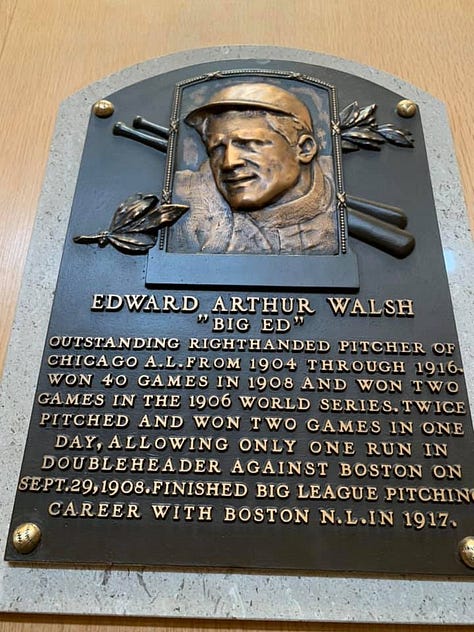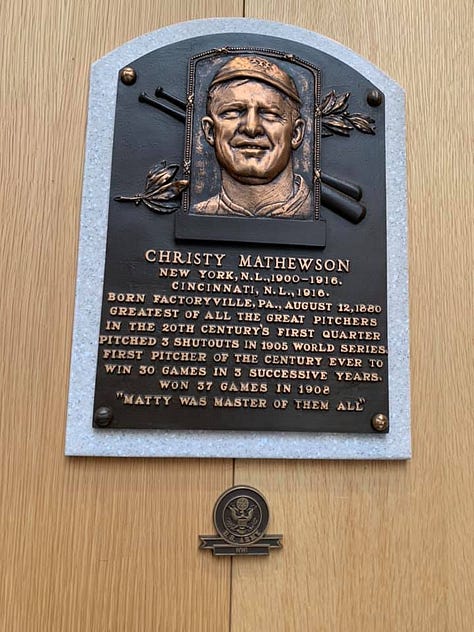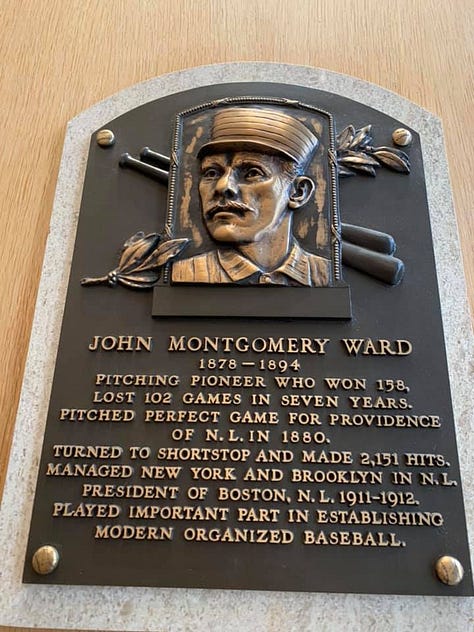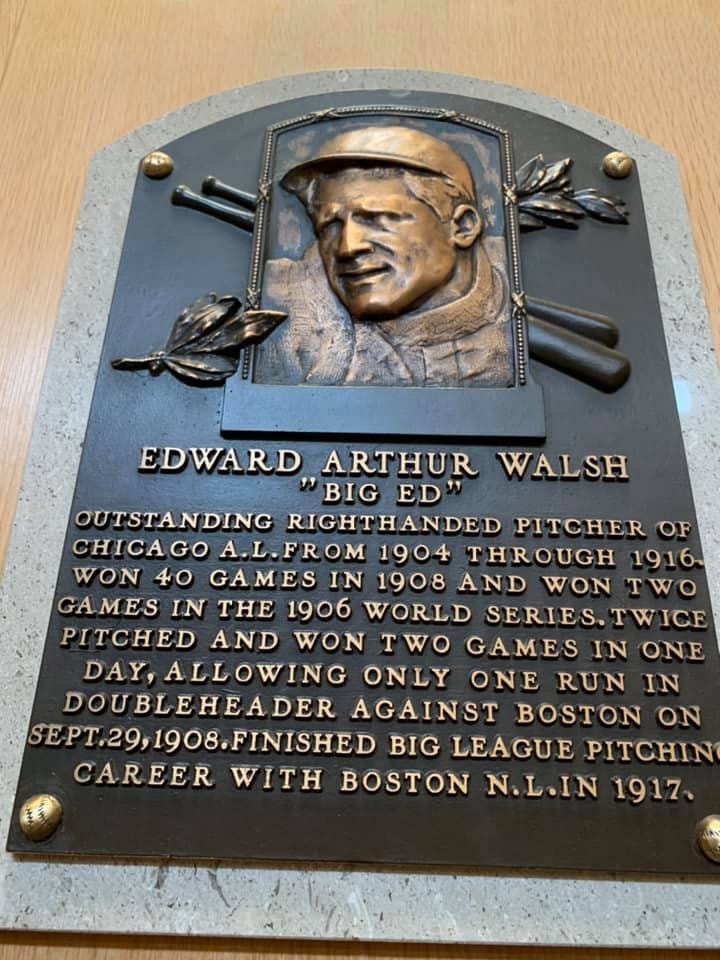


Have you ever seen a Major League Baseball Hall of Fame plaque in Cooperstown? Kind of underwhelming, isn’t it? They’re about 15 1/2 inches by nearly 11 inches, so they’re far from imposing. Each has a sculpture of a player it represents on it. Sometimes you even laugh at how little the image looks like the player your remember. Some are faded where people touch them.
What has always fascinated me is that they’re not uniform. Sure, they all have the player’s name in all caps and maybe a nickname underneath. Others have the years the player played. Some have the years and the teams. Some list the players statistics. Others tell a brief story. I think that says a lot about the Hall of Fame itself. At its core, it has an inconsistency that is not just quirky, it’s beautiful. It shows us how baseball itself means something different to each person.
For you, it might bring back memories of Little League glory. For someone else, it might mean connections with their father or mother, a cherished family heirloom. It might be something even more ephemeral. To some, it clearly still represents the country that we have, or had, or could have. Yet someone from the Dominican Republic or Mexico can take great pride in their own country’s baseball heritage.
One of the great joys for almost all baseball fans from any background is arguing about the damned thing. It’s fun advocating for your guy. It’s politics without the hate. OK, there’s some hate. But it’s acceptable and playful - even if at times just as delusional. As someone who takes Hall of Fame debates way too seriously, I’ve noticed some clear common threads.
One thing that I’ve been fascinated by is people’s perception of what makes someone a Hall of Famer. People come to the Hall of Fame with different expectations of who they would put in their own personal Hall of Fame. They might be BIG Hall people or SMALL HALL people.
THE RUSHMORES
Of course, there are the players who define the game. They’re players who so dominated the sport they are automatically in every sane person’s Hall of Fame.
Babe Ruth, Mickey Mantle, Joe DiMaggio, Ted Williams, Jackie Robinson, Willie Mays.
These are the people everyone thinks of when it comes to the Hall of Fame.
But as with every group, there are as many problems as there are benefits.
If you said that players had to be universally accepted as Hall of Famers, you’d still run into problems. Remember, none of the players above was a unanimous selection.
Well, the writers are idiots!
Maybe, but it’s hard to imagine getting a unanimous selection on some of the game’s greatest players. But before we get to that, let’s talk about what the writers have gotten correct.
For the most part, they’ve kept Cooperstown from becoming the most dreaded thing you hear in these debates: The Hall of Very Good.
The writers didn’t put in Harold Baines, the most controversial recent inductee. He was put in by a committee made up of former players, baseball officials with a few writers sprinkled in.
Let’s go back to the point about unanimous decisions and look at a few players.
First up, Satchel Paige. For my money, he’s the greatest player of all time. He played for so long that he competed against everyone from Ruth to Carl Yastrzemski. When he played in the Big Leagues at a very advanced age, he was very successful.
Did you know that Satchel appeared in 179 games, all after the age of 41, and he pitched to a 3.29 ERA and earned two trips to the All Star Game?
It’s hard to imagine he could do that and not have been other worldly in his prime. I sincerely believe, if he’d been allowed to play, he’d have set incredible records.
Would he be unanimous?
How about Pete Rose? Barry Bonds?
If you ask people to name the 20 or 50 greatest players, could they do it and be fair to every era? Would it suffer from too much recency bias?
Since it clearly has to be more than just a feeling, how do you measure what it means to be a Hall of Famer?
THE DOMINATORS
Some players’ dominance is easily recorded.
Look at Rogers Hornsby. He led the league in:
batting average seven times
runs scored five times
runs batted in, hits and doubles four times each
on-base percentage and slugging nine times each
From 1921-1924, he hit .402/474/690. That’s over 5 years.
Players like him are easy inductees. This seems like an obvious argument. You lead the league in a bunch of statistics, you’re in.
There are two problems, though with that line of thinking. The first is named Derek Jeter. In his brilliant 20-year career, he lead the league in exactly two offensive stats (Hits twice in 1999 and 2012, and runs in 1998)
Yeah, well, he was a complete player.
I’m not going to get into his lackluster defense, but let’s talk about baserunning and offense. Jeter, who clearly is a Hall of Famer, wasn’t incredibly dominant. He falls into the Tony Gwynn, Craig Biggio problem.
If you take someone to see they’re first Major League game, and they know nothing about baseball, they might not notice Gwynn or Biggio or Jeter during that first game. Instead, players like Roberto Alomar, Jeff Bagwell, Ken Caminiti, Bernie Williams, Jason Giambi, might impress them if they have a big day or make a big play.
However, if you take that person to a whole series, they’re probably more likely to walk away thinking those players were the best guys on their team.
The average Hall of Fame player leads the league in 27 categories. Again, that’s the average. Jeter has 10 black ink records. And no MVPs. The media loved Jeter, so that helped him get into the Top 5 in MVP voting five times. He also was consistently in the Top 10 in many offensive categories. He ended up with 3,000 hits, and he had all those post-season highlights.
It’s hard to imagine a player as good as Jeter, even without the league leading numbers, not getting into the Hall of Fame.
Now, let’s get to that second problem.
The Magic Numbers
How often during Hall of Fame debates have you heard “Oh, he didn’t win 300 games” or “He didn’t hit 500 homers” or “he didn’t get 3,000 hits” or some such magic number?
A lot. There’s a big problem with that.
Let’s just look at 300-games, which is the most problematic of those stats.
If you had to pick an all-time rotation, who would you pick?
Rotation 1
Don Sutton
Gaylord Perry
Steve Carlton
Grover Cleveland Alexander
Pud Galvin
Rotation 2
Bob Gibson
Jim Palmer
Sandy Koufax
Bob Feller
Pedro Martinez
Rotation 3
Greg Maddux
Kid Nichols
Tim Keefe
John Clarkson
Tom Glavine
You’re picking the second one, right? And it’s not even close. Well, that second rotation doesn’t have a single 300-game winner and each other rotation has five 300-game winners.
I know, if you’re a new school guy, you find wins as useless as the Mets in a stretch drive. However, they do tell us a lot about eras. In the late 1800s and early 1900s, they fell out of trees. Then they all but disappeared between 1930-1965 before re-emerging in the 1970s.
But each of those magic numbers, as exclusive a club as each is, has issues. They were never meant as a barometer for induction. Otherwise obvious inductees like Hank Greenberg, Joe DiMaggio and Roy Halladay wouldn’t get in.
So, who does belong?
IS THAT THE BEST QUESTION?
I’m not sure. I think it’s worth having a balanced argument. No single statistic is going to be a barometer, though they all help.
I’ve long argued that when people say “I’m a small hall guy” it’s usually a tell for them not really knowing baseball history. When someone says that, I like to ask “Does Walter Johnson belong?” Of course he does, when they were opening it, he was one of the original five. They literally put him in ahead of Cy Friggin’ Young. He had more votes than Babe Friggin’ Ruth.
Walter Johnson has a legitimate argument as the greatest pitcher of all time. If someone doesn’t want him in, they’re probably not worth listening to.
Sometimes I’ll sub in Craig Biggio, Robin Yount or Lefty Grove.
I like to turn the argument on its head.
What percentage of players should be in the Hall of Fame? Most people answer 1 or 2%. That’s a good barometer, right. The top 1% seems like a near magic number, but 2 percent doesn’t seem terrible.
So what percentage are enshrined? Would you gets 5%?
Well, nearly 21,000 players have suited up in a Major League uniform. About 272 players have been inducted. That’s 1.3 percent. However, of those 272, about 20 played solely in the Negro Leagues before the color barrier was broken, so the number is actually closer 1.2.
That seems pretty elite.
It’s OK if you’ve never heard of a player who was pretty elite. Sometimes - in the case of a Robin Yount or a Barry Larkin - they played outside of a major media environment. Other times, an old player with an incredible career has been lost to obscurity despite enshrinement.
That’s why it is fun to check out the plaques at Cooperstown.
Some of them are delightful.
RODNEY CLINE CAREW
Minnesota, A.L., 1967-1978
California, A.L., 1979-1985
Batting wizard who lined, chopped and bunted his way to 3,053 hits. 7 batting titles, surpassed only by Cobb and Wagner. Used variety of relaxed, crouched batting stances to hit over .300 15 consecutive seasons, achieving .328 lifetime. A.L. Rookie of the Year in 1967 and M.V.P. 10 years later when he batted .388 with 239 hits. Named to 18 straight All Star teams. National hero in Panama.
You’ve gotta love it. “National Hero in Panama,” Wizard, the award references, his distinct approach at the plate.
I’m going to repost Ed Walsh’s for you to look at.
Walsh was elected 45 years before Carew. You get the sense he was a big game pitcher and very durable. That 40 games won in 1908 is inconceivable now. Do you know what’s not there? Ed Walsh is the all time record holder in ERA. No pitcher ever has had a lower ERA than his 1.82. Sure, it was the deadball era, but he won two total ERA titles and was in the Top 10 seven times. Interestingly, he’s also first or in the top 5 all time in a lot of new stats, like FIP, WHIP and ERA+.
As much as we love arguing and discussing the Hall of Fame, it’s always wonderful to learn about players you didn’t know enough about.
It’s almost like that’s what it’s there for after all.




